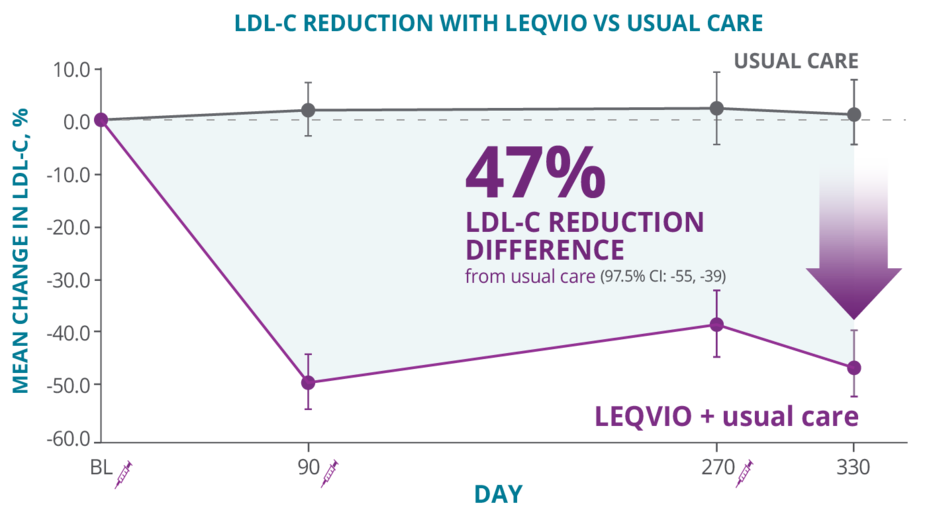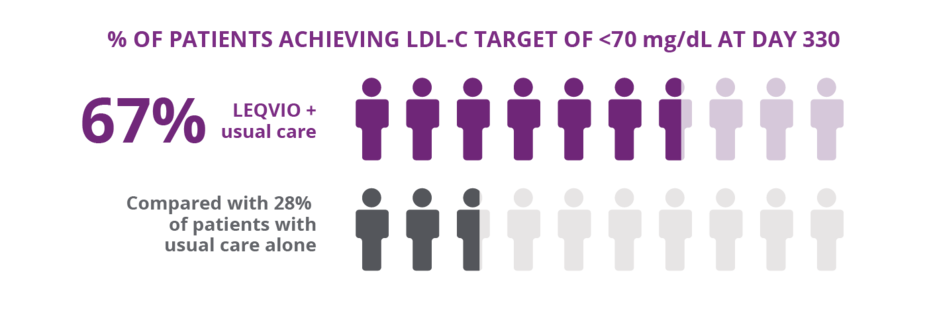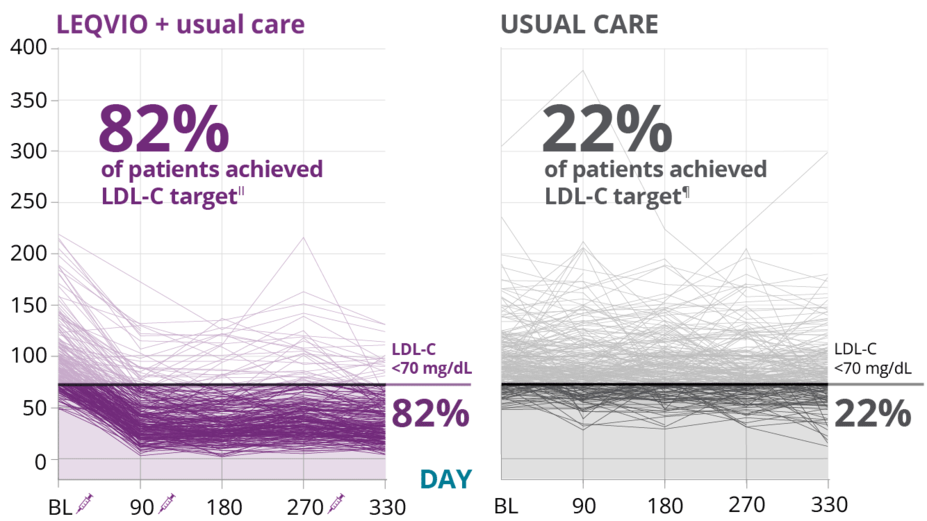
POWERFUL LDL-C REDUCTION AND LEQVIO® IN THE REAL-WORLD SETTING1,2
Pivotal Trials
In ORION-10 (N=1561) on top of a maximally tolerated statin, LEQVIO demonstrated:
52% LDL-C reduction in patients with ASCVD vs placebo at month 17 (95% CI: -56%, -49%; P<0.0001)1
84% of patients receiving LEQVIO achieved LDL-C target* <70 mg/dL vs 18% with placebo at month 173
75% of patients receiving LEQVIO achieved an LDL-C <55 mg/dL vs 4% of patients on placebo at month 173
Results were similar in patients with ASCVD in ORION-11.4,5
Study Design: ORION-10 (N=1561) & ORION-11 (N=1617) were multicenter, double-blind, randomized, placebo-controlled, 18-month, phase 3 trials in patients with established ASCVD (ORION-10 and ORION-11) or increased risk for CVD† (ORION-11). Patients were taking a maximally tolerated statin with or without other lipid-modifying therapy and required additional LDL-C reduction. The primary efficacy measure was the percentage change in LDL-C from baseline to day 510.1,6
*LDL-C target was <70 mg/dL for patients with ASCVD.1
†Factors that increase risk of CVD include HeFH, T2DM, or 10-year risk of ≥20%.6
Real-World Setting
LEQVIO Real-World Setting Study designs are aligned with the 2025 ACS Guideline
Latest guideline for patients with acute coronary syndromes, includes recommendations for LDL-C management
V-INCEPTION: LEQVIO initiation for LDL-C reduction shortly after a coronary event8‖
V-INCEPTION evaluated the efficacy and safety of LEQVIO plus usual care vs usual care alone in patients (N=400) who needed additional LDL-C lowering after a coronary event. Patients were screened within 5 weeks from their coronary event and the median time from discharge to treatment was 34 days.8
Usual care included statin and nonstatin, lipid-lowering treatment as considered appropriate by treating clinicians. At Day 330 (n=171), most patients in the usual care arm remained on statins only (67.8%, n=116), with a minority of patients receiving any additional nonstatin lipid-lowering therapy.9
‖An event is defined as acute coronary syndrome (unstable angina, STEMl, or NSTEMI).8
LDL-C reduction in patients was consistent with pivotal trials8
LEQVIO demonstrated a 47% LDL-C reduction difference from usual care alone at Day 330.
Percentage change in LDL-C from baseline
67% of patients achieved LDL-C target <70 mg/dL (co-primary endpoint) in the LEQVIO arm compared with 28% of patients receiving usual care alone.8
54% of patients achieved LDL-C target of <55 mg/dL (secondary endpoint) in the LEQVIO arm compared with 14% of patients receiving usual care alone.8
Limitations: Usual care did not reflect “best practice” with little use of guideline-recommended, nonstatin therapy; therefore, a comparison of efficacy or safety of LEQVIO vs other nonstatin therapies cannot be made. Not all participants in the LEQVIO arm received 3 doses of LEQVIO. LEQVIO use (1.5%; n=3) was not restricted in the usual care arm. The open-label design presented with inherent limitations, including higher dropout rates.8,9
With many nonstatin therapies available, usual care arm data show limited LLT utilization beyond statin, leaving patients above target, demonstrating clinical inertia in this population.8
V-INITIATE: LEQVIO vs usual care arm in a real-world setting
V-INITIATE compared immediate LEQVIO use after failure to reach LDL-C target¶ with maximally tolerated statin vs usual care, which was physician-determined based on the 2018 AHA/ACC guidelines.2
In the usual care arm, most patients (73%) remained on statins only, with a minority of patients receiving any additional nonstatin lipid-lowering therapy, including 10 patients who received at least 1 dose of LEQVIO.2
¶Guideline-recommended LDL-C target was <70 mg/dL for patients with ASCVD.3,10
Early LEQVIO use after failure to reach LDL-C target on statin2
LDL-C reduction with LEQVIO vs usual care
6% of patients in the LEQVIO arm vs 17% of patients in the usual care arm discontinued statins#
[-11% (97.5% CI: -18%, -3%)]2
#Statin discontinuation defined as no statin use for ≥30 days in patients without a history of statin intolerance.2
Study design for V-INITIATE: A 12-month, randomized, open-label, phase 3b study in patients with ASCVD (N=450) evaluated the efficacy and safety of early initiation with LEQVIO immediately upon failure to reach LDL-C <70 mg/dL on maximally tolerated statin vs usual care in a real-world setting.2
The co-primary end points were percentage change in LDL-C from baseline and statin discontinuation rate.2
Patients with ASCVD achieving LDL-C target2**
**Guideline-recommended LDL-C target was <70 mg/dL for patients with ASCVD.3,11
††73% of patients remained on statins only at Day 330.2
Limitations: Usual care did not reflect “best practice” with little use of guideline-recommended nonstatin therapy; therefore, a comparison of efficacy or safety of LEQVIO vs other nonstatin therapies cannot be made. LEQVIO use (n=10) was permitted in the usual care arm which may impact the effectiveness of comparisons. Although the study was designed to mimic clinical practice, statin discontinuation rates may not reflect the real world due to participants’ potential behavior change as a result of being part of a study. The open-label design has the potential for bias and may present difficulties in the interpretation of results.
Implementation of LEQVIO in a real-world setting: expert insights
Watch Dr Michael Koren, a clinical trial investigator for the V-INITIATE trial, discuss the importance of early LEQVIO use in patients with ASCVD (atherosclerotic cardiovascular disease), immediately after failure to reach LDL-C goals with statins.
There's more to know about LEQVIO
Discover the LEQVIO long-term efficacy data





